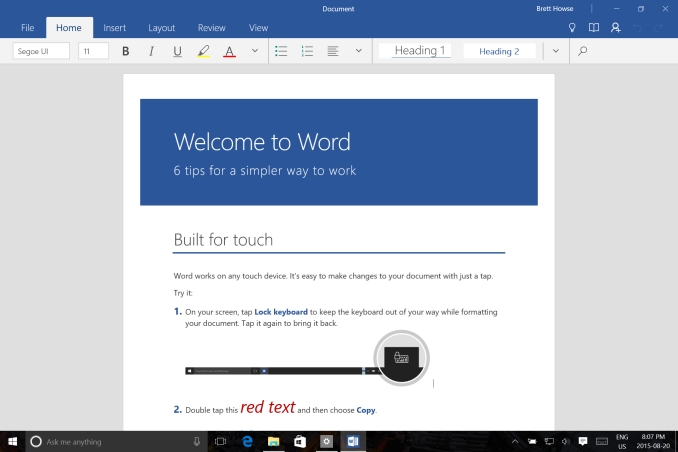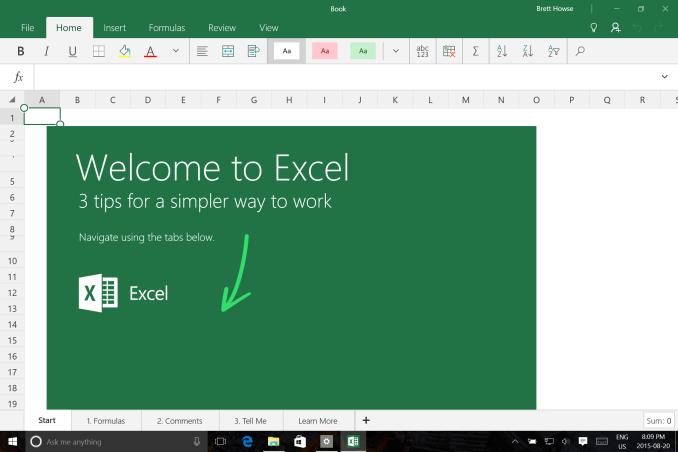The Windows 10 Review: The Old & New Face of Windows
by Brett Howse on August 25, 2015 8:00 AM EST- Posted in
- Operating Systems
- Microsoft
- Windows 10
Touch-Enabled Office Apps Arrive with Windows 10
When Windows 8 launched, Microsoft had built a touch-first version of their operating system, but they had not yet completed their touch-enabled version of their most popular productivity suite. In fact, in the almost three years between Windows 8 and Windows 10, Microsoft released Office on iOS first, and then Android, leaving their own platform as the only one without a touch-enabled version of Office. Finally, with Windows 10, Office Mobile is here.
These are, like practically all pieces of Windows 10, Windows Universal Apps, and therefore they are made to scale all the way from a phone to a large display desktop. Word, Excel, PowerPoint, and OneNote are all available. The experience is very similar to how it looks on the other platforms, and Microsoft has done a nice job keeping the look and feel consistent across the different mobile operating systems.
I think most people are familiar with the Office trio of Word, Excel, and PowerPoint, and perhaps not quite as familiar with OneNote, but the mobile apps are surprisingly competent versions, and can likely easily replace the full Office suite for a lot of people. If you need some of the extra functionality like conditional formatting in Excel, or the ability to open password protected documents, you will need to go with the full version of Office, at least for now.
In pretty typical Microsoft fashion, the apps have been created to allow basic file reading, creation, and editing for free, but if you want to access all of the features you need to purchase an Office 365 subscription. There is a big caveat here though. This only applies to devices under 10.1 inches in screen diameter. Anything larger than this requires a subscription to gain access to edit, which is a pretty big concession. According to Microsoft, they want to keep the free capabilities available for devices that are mostly used with touch, and the Office team feels this cut-off is 10.1 inches. Amazingly, the same company also sells a consumer version of their tablet line, the Surface 3, which is a 10.8 inch device and therefore over the cut-off. They do sell it with a one year subscription, but it’s a rather odd way to market the new Office Mobile apps.
There is also a new piece to the Office puzzle, which is called Sway. Luckily, like OneNote, Sway is free for all users. So what is Sway? It is an interactive storytelling app, and it lets you easily add some text and media, and it will create a sway for you. It’s very much a cloud based app, and you can share links to your sway to view or edit. Think of it like a simpler version of PowerPoint. Here is a sway as an example of what it can do.
OneNote is of course back, and this is Microsoft’s app which lets you do a lot more than just take notes. The touch version is changed from Windows 8, and it now fits in with the theme of the other Office Mobile apps. Fans of the Windows 8 version’s radial menu will be disappointed though since that has gotten the axe.
I think the capabilities of these apps are going to improve over time, but it is unlikely they will ever offer the full functionality of the desktop version of Office. They are targeted towards a different set of needs. It was certainly one of the key missing pieces of the Windows 8 era, so it is great that they have made their debut with Windows 10. Only OneNote is installed out of the box, and the other apps can be found in the store.














293 Comments
View All Comments
zman58 - Thursday, October 15, 2015 - link
"worlds largest and most obnoxious spyware"We really don't know exactly what data it sends back on the user and their system(s) do we? The EULA does not detail this for us. In fact, the EULA has you agree to whatever they desire from your system--for improving the product. The spyware option is purely opt-out, for those of us who know what opt-out means and are capable of figuring out how to opt-out.
Then once you can/do opt-out, how can you be assured you will remain opted-out through upgrades, hot-fixes, patches, and what-not?
Bottom line is that the vendor decides what and when they want to collect data from your system, you have absolutely no control over them. Read the EULA and consider what it means before you click "I agree". You might not want to click that button...
Perhaps using an alternative reliable, safe, secure, and private operating system might be a better approach. ...Well hello there Linux.
bs grinder - Tuesday, December 26, 2017 - link
thanxjohn
ddriver - Wednesday, August 26, 2015 - link
"The privacy concerns are certainly not overblown, but for most people, they will make the trade-off of less privacy if it means an improved experience. The textbook example here is advertising, where in order to deliver relevant ads to the user"Ah yeas, I bet the whole world rejoices being able to give up their privacy to be blasted with ads. It is a great trade-off indeed.
"If you are concerned, the best thing to do is to read the privacy statement and adjust your settings accordingly."
I bet that's the best you can do, pretending that somehow clicking a button or two magically makes all problems go away
Also, I see a catch in those "privacy settings". You seem to only be able to turn off "sending MS info", but that doesn't imply that data is still not being mined and sent anywhere else.
imaheadcase - Wednesday, August 26, 2015 - link
You are aware these settings are present in almost almost win OS? The only privacy stuff they collect is related to MS services, onedrive, etc. Just because win 10 gave people options (gasp!) vs win 8 and 7 does not mean those did not, and still do have it.ddriver - Wednesday, August 26, 2015 - link
No they are not. Especially if you bother to watch what updates you install. For example, MS will try to sneak in the "telemetry" data miner service on your windows 7 as an update, but it is not there to begin with.I haven't used and will likely never use a windows version after 7, but in a "clean" windows 7 install none of the win 10 invasions of privacy are present. It doesn't keylog, it doesn't listen to speech, it doesn't analyze text or file content and it doesn't report everything you do back home.
Oh, and you can also chose not to install certain updates, whereas with the "nice free" windows 10 MS get to deploy on your system whatever it wants - all in the name of your comfort.
Michael Bay - Wednesday, August 26, 2015 - link
Your religious belief in 7 is amusing, at least.ddriver - Thursday, August 27, 2015 - link
If anyone around here is a believer, that is you, believing MS are trustworthy that is.Gigaplex - Friday, August 28, 2015 - link
If you don't trust MS, you shouldn't be using any version of Windows.althaz - Thursday, August 27, 2015 - link
FYI: Windows 7 collects telemetry by default. It was turned off by default in Vista and XP, but most OEMs turned it on for you. So Win 10 is collecting the same information as Windows XP, Vista and 7 (and 8), for most people.yuhong - Friday, August 28, 2015 - link
Does Win10 really "keylog" outside of search boxes and the like? search suggestions are not new either. There is no evidence that Win10 can read arbitrary files either.